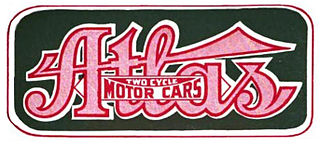
Elmore Manufacturing Company was a manufacturer of veteran and brass era automobiles and bicycles (1893–97), headquartered at 504 Amanda Street, Clyde, Ohio, from 1893 until 1912. The company took its name from a small parcel of land in Clyde with the name Elmore associated with it where a stave mill was established originally, then evolved into bicycle production. The village of Elmore, Ohio is located 20 mi (32.2 km) to the east. Founded by Harmon Von Vechten Becker and his two sons, James and Burton, the Elmore used a two-stroke engine design, in straight twin or single-cylinder versions. They later produced a straight-3 followed by a straight-4 beginning in 1906 until production ended in 1912. The company advertising slogan was "The Car That Has No Valves", referring to the two-stroke engine.

Stevens-Duryea was an American manufacturer of Veteran and Brass Era automobiles in Chicopee Falls, Massachusetts, between 1901 and 1915 and Vintage Cars from 1919 to 1927.

McFarlan was a luxury American automobile manufactured in Connersville, Indiana, from 1909 to 1928, by the McFarlan Carriage Company and the McFarlan Motor Car Company.

The Marion was an automobile produced by the Marion Motor Car Company in Indianapolis, Indiana from 1904 to 1915.

Single Center Spring Buggy Company was an American carriage and automobile manufacturer based in Evansville, Indiana. The Single Center factory manufactured the Zentmobile, Zent, Windsor, Worth, Single Center, Evansville, Simplicity and Traveler automobiles from 1903 to 1910.

The Standard Six was an American automobile manufactured in St. Louis, Missouri by the St. Louis Car Company from 1909 until 1910. The company initially built the French Mors cars under license as the American Mors from 1906 to 1909. In 1910, Standard Six manufacturing was moved to Wabash, Indiana where production ended in 1911.
Spaulding was used as an automobile marque by two separate companies. The Spaulding Automobile and Motor Company of Buffalo, New York built Veteran Era automobiles in 1902 and 1903. Spaulding Manufacturing Company of Grinnell, Iowa built Brass Era automobiles from 1910 to 1916.

The Speedwell Motor Car Company was a Brass Era American automobile manufacturing company established by Pierce Davies Schenck that produced cars from 1907 to 1914. The Great Dayton Flood of 1913 greatly damaged the Speedwell factory and inventory, and the company entered receivership in 1915 after having built an estimated 4,000 cars and trucks.

The Smith Automobile Company of Topeka, Kansas, was an early United States automobile manufacturing company which produced the Veracity, Smith, and Great Smith lines of automobiles from 1902 to 1911. They were the first automobiles made west of the Mississippi River.

The Moline Automobile Company, was an American brass era automobile manufacturer in East Moline, Illinois known for the Moline, Dreadnought Moline,Moline-Knight and R & V Knight marques.

The Selden Motor Vehicle Company was a Brass Era American manufacturer of automobiles. The company, founded in 1906, was based in Rochester, New York, and built automobiles from 1907 to 1914 and trucks from 1913 to 1932.

Schacht was an American marque of automobiles and High-wheelers from 1904 to 1913, in Cincinnati, Ohio. The Schacht Manufacturing Company, later renamed Schacht Motor Car Company produced over 9,000 automobiles. The company was reorganized as the G.A. Schacht Motor Truck Company in 1914 and production of trucks and fire trucks continued until 1938.

The Model Automobile Company was a brass era American automobile manufacturer located in Peru, Indiana from 1902 to 1909.

Rainier Motor Car Company was an American automobile manufacturer founded in 1905 by John T. Rainier in Flushing, New York and from 1908 produced in Saginaw, Michigan. The company specialized in manufacturing large and luxurious automobiles. In 1909, the company was bought by General Motors who maintained the brand until 1911.

The W. H. Kiblinger Company and the W. H. McIntyre Company produced Brass Era automobiles in Auburn, Indiana from 1907 to 1915.

The Atlas car was built in Springfield, Massachusetts from 1907 to 1911.

The Simplex Automobile Company was formed in 1907 to take over the manufacturer of the S & M Simplex. The Simplex was an American luxury Brass Era automobile manufactured from 1907 to 1918. Headquartered with a manufacturing plant in New York City, manufacturing from 1912 was in New Brunswick, New Jersey. The Simplex Crane Model 5 was commonly called Simplex-Crane and Crane-Simplex. The Crane-Simplex Company of Long Island, New York, was an attempt in 1922 to revive the brand but closed after only a few chassis were built.
The Welch Motor Company was an American automobile company headquartered in Chelsea, Michigan. It began in 1901 and continued production of luxury vehicles until 1911 when it merged with General Motors.

The Mason was a Brass Era automobile manufactured in Des Moines, Iowa from 1906 to 1909 and Waterloo, Iowa from 1911 to 1914. In 1909 and 1910 it was marketed as the Maytag-Mason.


























